Reflective Essay: Professional Nursing Practice in Australia
VerifiedAdded on 2022/10/18
|7
|1606
|11
Essay
AI Summary
This essay delves into the scope of practice for registered nurses, specifically within the Australian healthcare context. It begins by defining the scope of practice, encompassing the responsibilities and activities nurses are trained to perform, including health promotion, maintenance, and restoration. The essay then analyzes the current healthcare demands in Australia, emphasizing the challenges posed by an aging population, chronic illnesses, and evolving technologies. It highlights the need for a well-defined scope of practice to ensure nurses can effectively meet patient needs. The author reflects on their clinical placement experiences, identifying a strong interest in oncology nursing and discussing the skills and knowledge gained in an acute care ward. The essay underscores the importance of critical thinking, collaboration, and evidence-based practice in delivering quality patient care, supported by relevant research and literature.
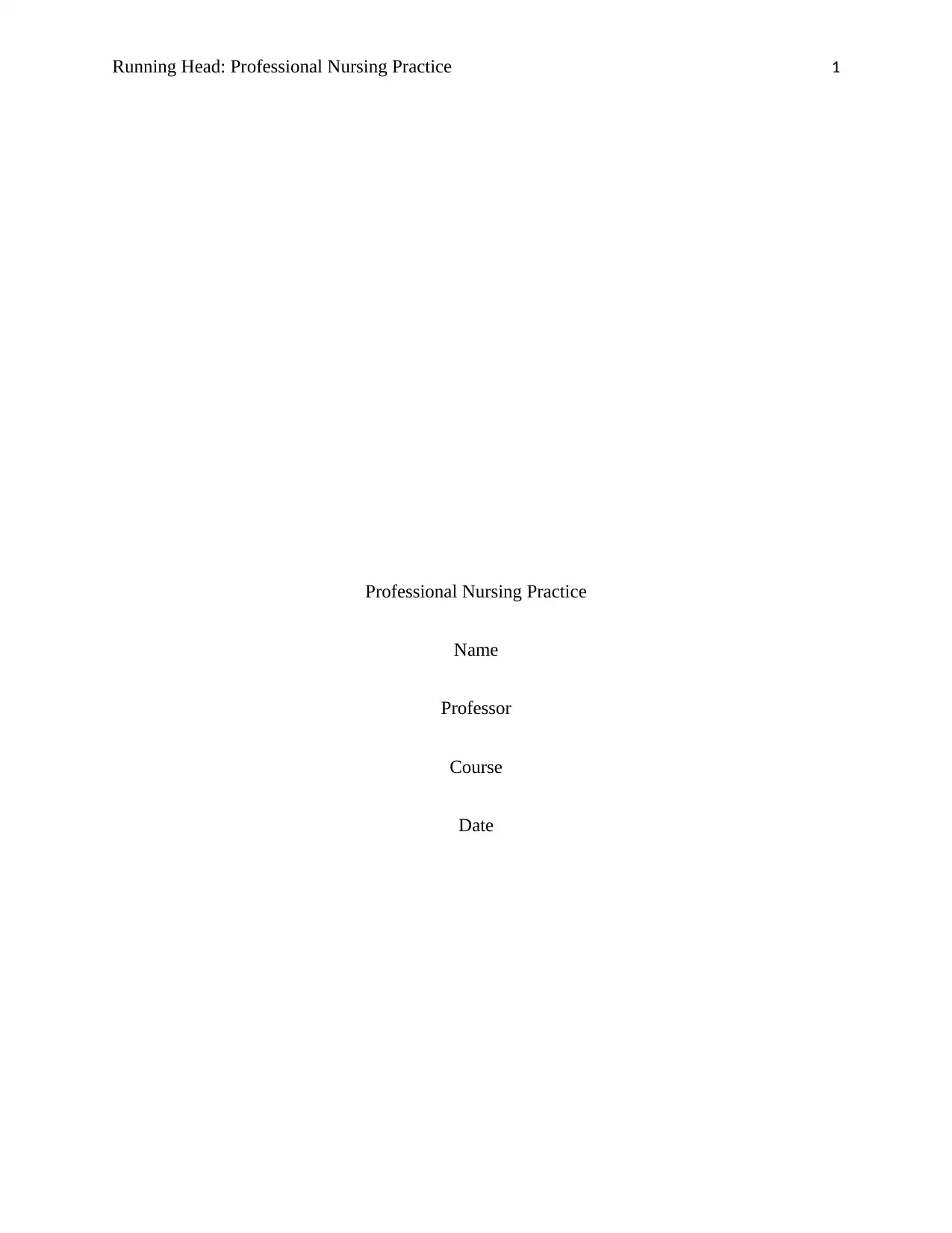
Running Head: Professional Nursing Practice 1
Professional Nursing Practice
Name
Professor
Course
Date
Professional Nursing Practice
Name
Professor
Course
Date
Paraphrase This Document
Need a fresh take? Get an instant paraphrase of this document with our AI Paraphraser
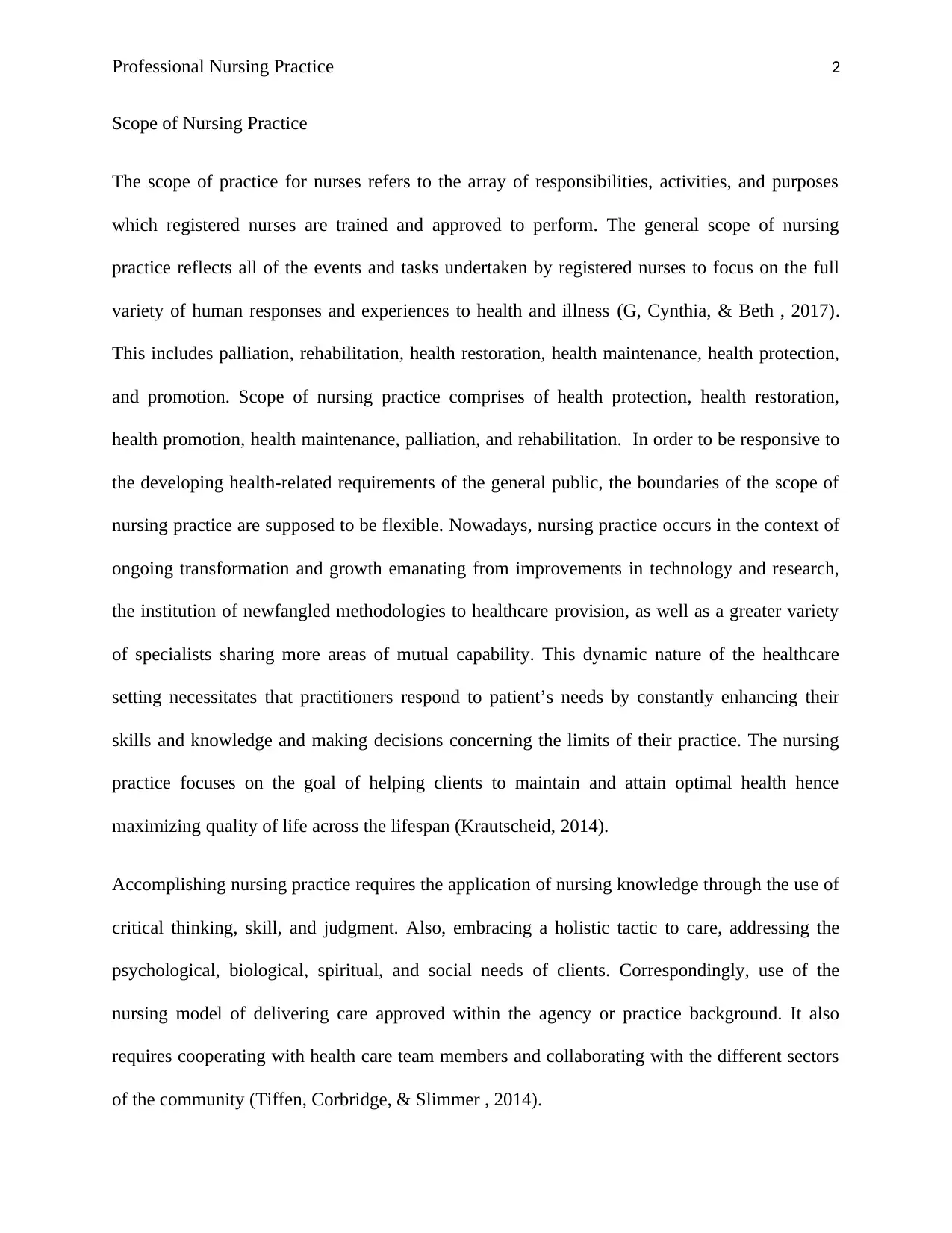
Professional Nursing Practice 2
Scope of Nursing Practice
The scope of practice for nurses refers to the array of responsibilities, activities, and purposes
which registered nurses are trained and approved to perform. The general scope of nursing
practice reflects all of the events and tasks undertaken by registered nurses to focus on the full
variety of human responses and experiences to health and illness (G, Cynthia, & Beth , 2017).
This includes palliation, rehabilitation, health restoration, health maintenance, health protection,
and promotion. Scope of nursing practice comprises of health protection, health restoration,
health promotion, health maintenance, palliation, and rehabilitation. In order to be responsive to
the developing health-related requirements of the general public, the boundaries of the scope of
nursing practice are supposed to be flexible. Nowadays, nursing practice occurs in the context of
ongoing transformation and growth emanating from improvements in technology and research,
the institution of newfangled methodologies to healthcare provision, as well as a greater variety
of specialists sharing more areas of mutual capability. This dynamic nature of the healthcare
setting necessitates that practitioners respond to patient’s needs by constantly enhancing their
skills and knowledge and making decisions concerning the limits of their practice. The nursing
practice focuses on the goal of helping clients to maintain and attain optimal health hence
maximizing quality of life across the lifespan (Krautscheid, 2014).
Accomplishing nursing practice requires the application of nursing knowledge through the use of
critical thinking, skill, and judgment. Also, embracing a holistic tactic to care, addressing the
psychological, biological, spiritual, and social needs of clients. Correspondingly, use of the
nursing model of delivering care approved within the agency or practice background. It also
requires cooperating with health care team members and collaborating with the different sectors
of the community (Tiffen, Corbridge, & Slimmer , 2014).
Scope of Nursing Practice
The scope of practice for nurses refers to the array of responsibilities, activities, and purposes
which registered nurses are trained and approved to perform. The general scope of nursing
practice reflects all of the events and tasks undertaken by registered nurses to focus on the full
variety of human responses and experiences to health and illness (G, Cynthia, & Beth , 2017).
This includes palliation, rehabilitation, health restoration, health maintenance, health protection,
and promotion. Scope of nursing practice comprises of health protection, health restoration,
health promotion, health maintenance, palliation, and rehabilitation. In order to be responsive to
the developing health-related requirements of the general public, the boundaries of the scope of
nursing practice are supposed to be flexible. Nowadays, nursing practice occurs in the context of
ongoing transformation and growth emanating from improvements in technology and research,
the institution of newfangled methodologies to healthcare provision, as well as a greater variety
of specialists sharing more areas of mutual capability. This dynamic nature of the healthcare
setting necessitates that practitioners respond to patient’s needs by constantly enhancing their
skills and knowledge and making decisions concerning the limits of their practice. The nursing
practice focuses on the goal of helping clients to maintain and attain optimal health hence
maximizing quality of life across the lifespan (Krautscheid, 2014).
Accomplishing nursing practice requires the application of nursing knowledge through the use of
critical thinking, skill, and judgment. Also, embracing a holistic tactic to care, addressing the
psychological, biological, spiritual, and social needs of clients. Correspondingly, use of the
nursing model of delivering care approved within the agency or practice background. It also
requires cooperating with health care team members and collaborating with the different sectors
of the community (Tiffen, Corbridge, & Slimmer , 2014).
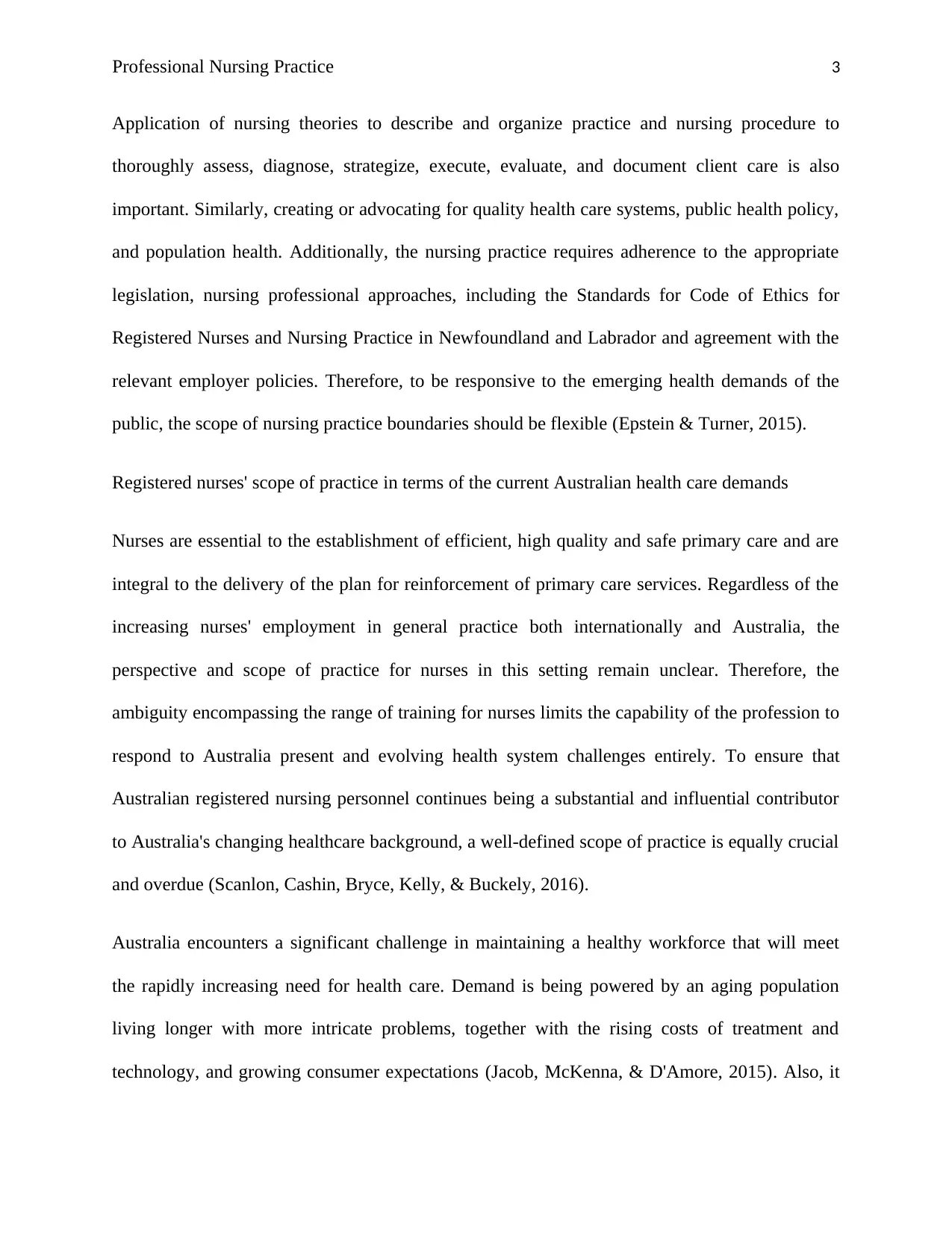
Professional Nursing Practice 3
Application of nursing theories to describe and organize practice and nursing procedure to
thoroughly assess, diagnose, strategize, execute, evaluate, and document client care is also
important. Similarly, creating or advocating for quality health care systems, public health policy,
and population health. Additionally, the nursing practice requires adherence to the appropriate
legislation, nursing professional approaches, including the Standards for Code of Ethics for
Registered Nurses and Nursing Practice in Newfoundland and Labrador and agreement with the
relevant employer policies. Therefore, to be responsive to the emerging health demands of the
public, the scope of nursing practice boundaries should be flexible (Epstein & Turner, 2015).
Registered nurses' scope of practice in terms of the current Australian health care demands
Nurses are essential to the establishment of efficient, high quality and safe primary care and are
integral to the delivery of the plan for reinforcement of primary care services. Regardless of the
increasing nurses' employment in general practice both internationally and Australia, the
perspective and scope of practice for nurses in this setting remain unclear. Therefore, the
ambiguity encompassing the range of training for nurses limits the capability of the profession to
respond to Australia present and evolving health system challenges entirely. To ensure that
Australian registered nursing personnel continues being a substantial and influential contributor
to Australia's changing healthcare background, a well-defined scope of practice is equally crucial
and overdue (Scanlon, Cashin, Bryce, Kelly, & Buckely, 2016).
Australia encounters a significant challenge in maintaining a healthy workforce that will meet
the rapidly increasing need for health care. Demand is being powered by an aging population
living longer with more intricate problems, together with the rising costs of treatment and
technology, and growing consumer expectations (Jacob, McKenna, & D'Amore, 2015). Also, it
Application of nursing theories to describe and organize practice and nursing procedure to
thoroughly assess, diagnose, strategize, execute, evaluate, and document client care is also
important. Similarly, creating or advocating for quality health care systems, public health policy,
and population health. Additionally, the nursing practice requires adherence to the appropriate
legislation, nursing professional approaches, including the Standards for Code of Ethics for
Registered Nurses and Nursing Practice in Newfoundland and Labrador and agreement with the
relevant employer policies. Therefore, to be responsive to the emerging health demands of the
public, the scope of nursing practice boundaries should be flexible (Epstein & Turner, 2015).
Registered nurses' scope of practice in terms of the current Australian health care demands
Nurses are essential to the establishment of efficient, high quality and safe primary care and are
integral to the delivery of the plan for reinforcement of primary care services. Regardless of the
increasing nurses' employment in general practice both internationally and Australia, the
perspective and scope of practice for nurses in this setting remain unclear. Therefore, the
ambiguity encompassing the range of training for nurses limits the capability of the profession to
respond to Australia present and evolving health system challenges entirely. To ensure that
Australian registered nursing personnel continues being a substantial and influential contributor
to Australia's changing healthcare background, a well-defined scope of practice is equally crucial
and overdue (Scanlon, Cashin, Bryce, Kelly, & Buckely, 2016).
Australia encounters a significant challenge in maintaining a healthy workforce that will meet
the rapidly increasing need for health care. Demand is being powered by an aging population
living longer with more intricate problems, together with the rising costs of treatment and
technology, and growing consumer expectations (Jacob, McKenna, & D'Amore, 2015). Also, it
⊘ This is a preview!⊘
Do you want full access?
Subscribe today to unlock all pages.

Trusted by 1+ million students worldwide
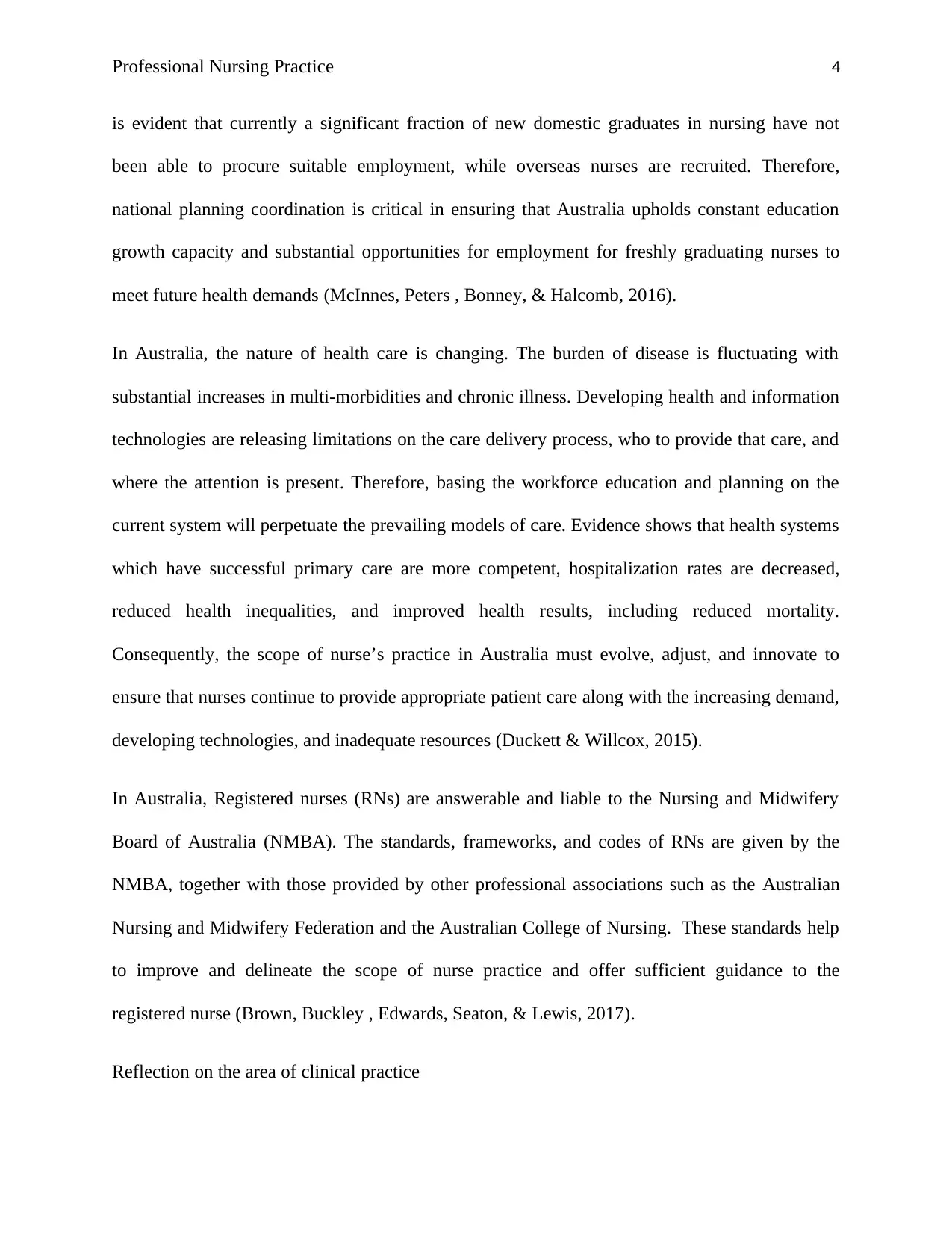
Professional Nursing Practice 4
is evident that currently a significant fraction of new domestic graduates in nursing have not
been able to procure suitable employment, while overseas nurses are recruited. Therefore,
national planning coordination is critical in ensuring that Australia upholds constant education
growth capacity and substantial opportunities for employment for freshly graduating nurses to
meet future health demands (McInnes, Peters , Bonney, & Halcomb, 2016).
In Australia, the nature of health care is changing. The burden of disease is fluctuating with
substantial increases in multi-morbidities and chronic illness. Developing health and information
technologies are releasing limitations on the care delivery process, who to provide that care, and
where the attention is present. Therefore, basing the workforce education and planning on the
current system will perpetuate the prevailing models of care. Evidence shows that health systems
which have successful primary care are more competent, hospitalization rates are decreased,
reduced health inequalities, and improved health results, including reduced mortality.
Consequently, the scope of nurse’s practice in Australia must evolve, adjust, and innovate to
ensure that nurses continue to provide appropriate patient care along with the increasing demand,
developing technologies, and inadequate resources (Duckett & Willcox, 2015).
In Australia, Registered nurses (RNs) are answerable and liable to the Nursing and Midwifery
Board of Australia (NMBA). The standards, frameworks, and codes of RNs are given by the
NMBA, together with those provided by other professional associations such as the Australian
Nursing and Midwifery Federation and the Australian College of Nursing. These standards help
to improve and delineate the scope of nurse practice and offer sufficient guidance to the
registered nurse (Brown, Buckley , Edwards, Seaton, & Lewis, 2017).
Reflection on the area of clinical practice
is evident that currently a significant fraction of new domestic graduates in nursing have not
been able to procure suitable employment, while overseas nurses are recruited. Therefore,
national planning coordination is critical in ensuring that Australia upholds constant education
growth capacity and substantial opportunities for employment for freshly graduating nurses to
meet future health demands (McInnes, Peters , Bonney, & Halcomb, 2016).
In Australia, the nature of health care is changing. The burden of disease is fluctuating with
substantial increases in multi-morbidities and chronic illness. Developing health and information
technologies are releasing limitations on the care delivery process, who to provide that care, and
where the attention is present. Therefore, basing the workforce education and planning on the
current system will perpetuate the prevailing models of care. Evidence shows that health systems
which have successful primary care are more competent, hospitalization rates are decreased,
reduced health inequalities, and improved health results, including reduced mortality.
Consequently, the scope of nurse’s practice in Australia must evolve, adjust, and innovate to
ensure that nurses continue to provide appropriate patient care along with the increasing demand,
developing technologies, and inadequate resources (Duckett & Willcox, 2015).
In Australia, Registered nurses (RNs) are answerable and liable to the Nursing and Midwifery
Board of Australia (NMBA). The standards, frameworks, and codes of RNs are given by the
NMBA, together with those provided by other professional associations such as the Australian
Nursing and Midwifery Federation and the Australian College of Nursing. These standards help
to improve and delineate the scope of nurse practice and offer sufficient guidance to the
registered nurse (Brown, Buckley , Edwards, Seaton, & Lewis, 2017).
Reflection on the area of clinical practice
Paraphrase This Document
Need a fresh take? Get an instant paraphrase of this document with our AI Paraphraser
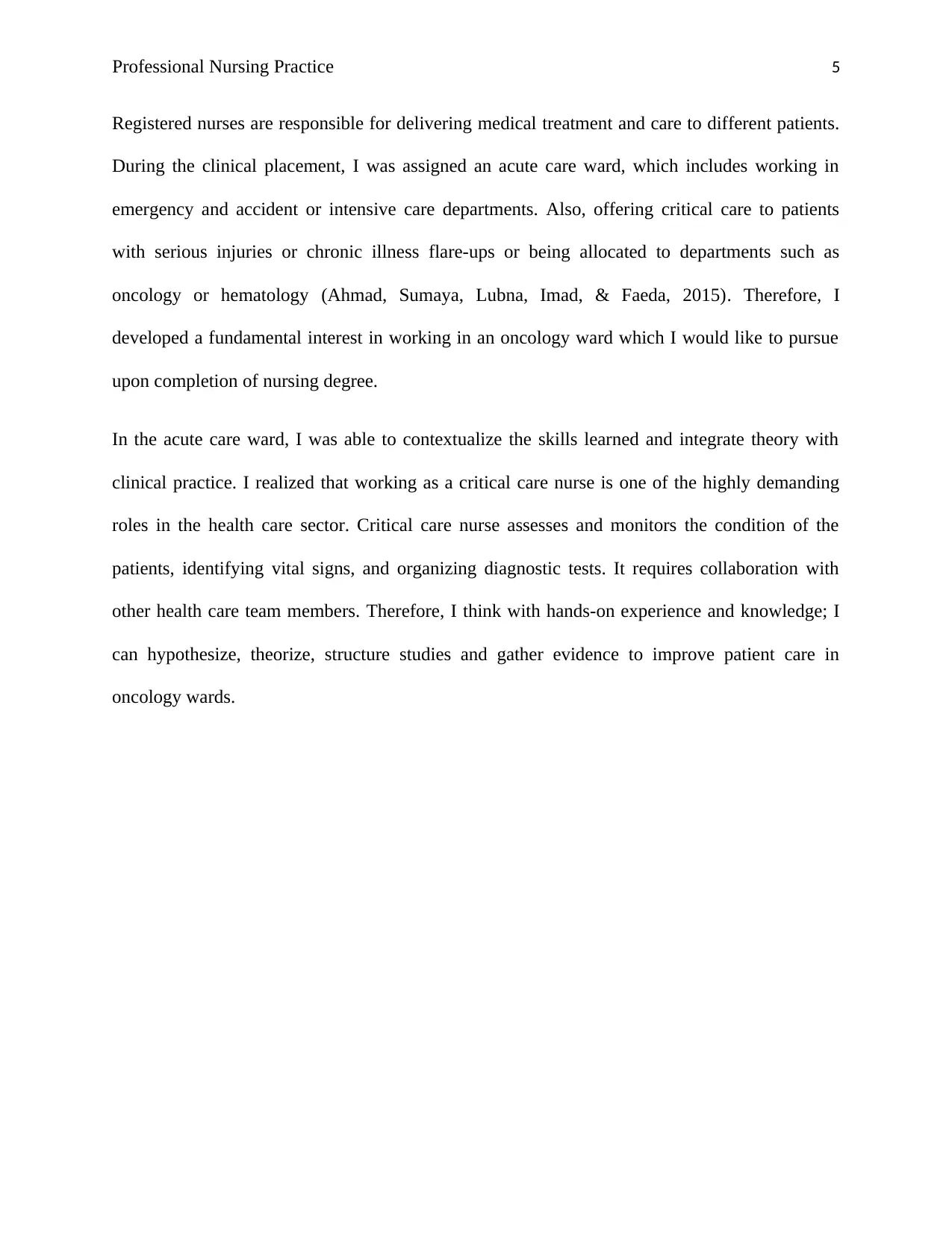
Professional Nursing Practice 5
Registered nurses are responsible for delivering medical treatment and care to different patients.
During the clinical placement, I was assigned an acute care ward, which includes working in
emergency and accident or intensive care departments. Also, offering critical care to patients
with serious injuries or chronic illness flare-ups or being allocated to departments such as
oncology or hematology (Ahmad, Sumaya, Lubna, Imad, & Faeda, 2015). Therefore, I
developed a fundamental interest in working in an oncology ward which I would like to pursue
upon completion of nursing degree.
In the acute care ward, I was able to contextualize the skills learned and integrate theory with
clinical practice. I realized that working as a critical care nurse is one of the highly demanding
roles in the health care sector. Critical care nurse assesses and monitors the condition of the
patients, identifying vital signs, and organizing diagnostic tests. It requires collaboration with
other health care team members. Therefore, I think with hands-on experience and knowledge; I
can hypothesize, theorize, structure studies and gather evidence to improve patient care in
oncology wards.
Registered nurses are responsible for delivering medical treatment and care to different patients.
During the clinical placement, I was assigned an acute care ward, which includes working in
emergency and accident or intensive care departments. Also, offering critical care to patients
with serious injuries or chronic illness flare-ups or being allocated to departments such as
oncology or hematology (Ahmad, Sumaya, Lubna, Imad, & Faeda, 2015). Therefore, I
developed a fundamental interest in working in an oncology ward which I would like to pursue
upon completion of nursing degree.
In the acute care ward, I was able to contextualize the skills learned and integrate theory with
clinical practice. I realized that working as a critical care nurse is one of the highly demanding
roles in the health care sector. Critical care nurse assesses and monitors the condition of the
patients, identifying vital signs, and organizing diagnostic tests. It requires collaboration with
other health care team members. Therefore, I think with hands-on experience and knowledge; I
can hypothesize, theorize, structure studies and gather evidence to improve patient care in
oncology wards.
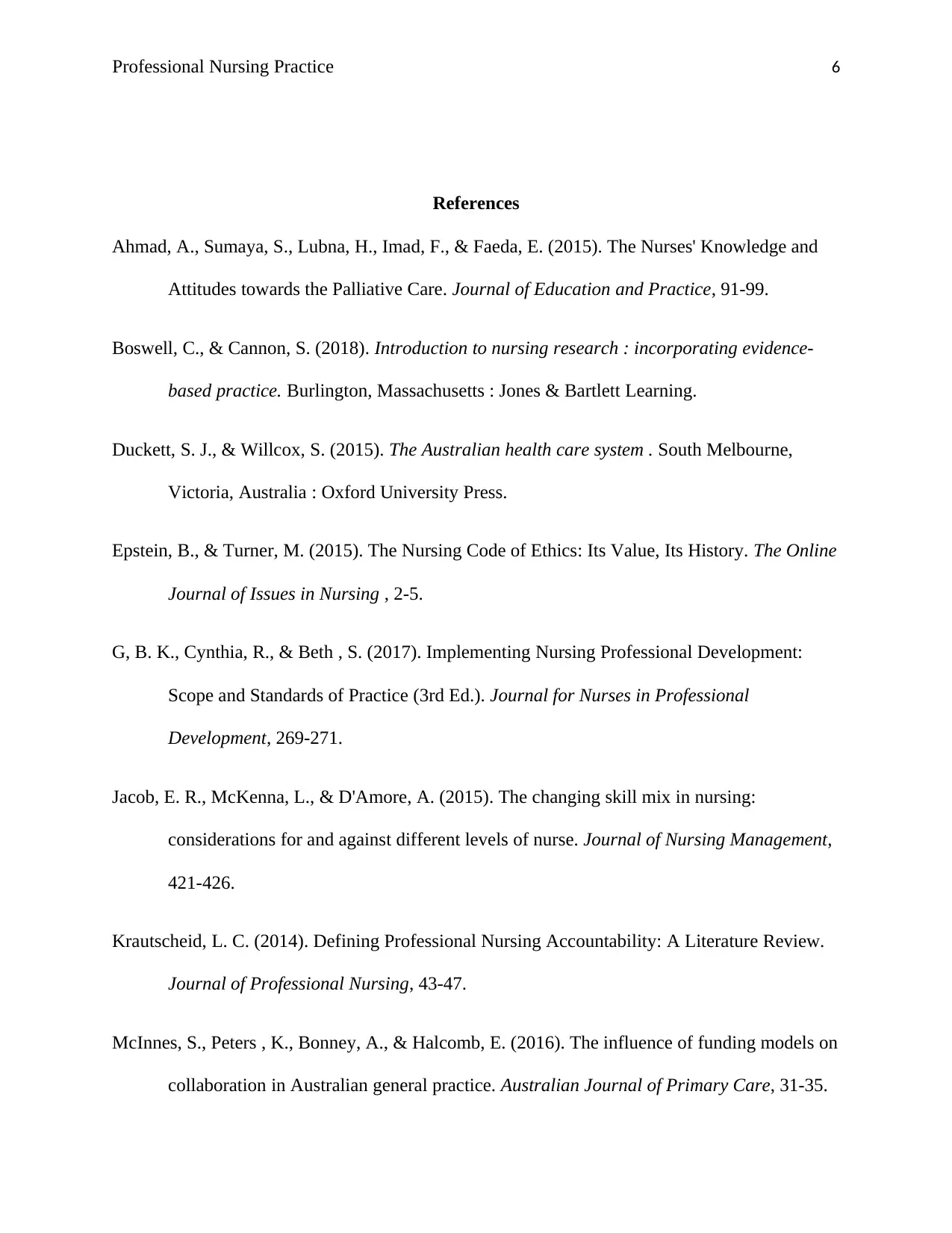
Professional Nursing Practice 6
References
Ahmad, A., Sumaya, S., Lubna, H., Imad, F., & Faeda, E. (2015). The Nurses' Knowledge and
Attitudes towards the Palliative Care. Journal of Education and Practice, 91-99.
Boswell, C., & Cannon, S. (2018). Introduction to nursing research : incorporating evidence-
based practice. Burlington, Massachusetts : Jones & Bartlett Learning.
Duckett, S. J., & Willcox, S. (2015). The Australian health care system . South Melbourne,
Victoria, Australia : Oxford University Press.
Epstein, B., & Turner, M. (2015). The Nursing Code of Ethics: Its Value, Its History. The Online
Journal of Issues in Nursing , 2-5.
G, B. K., Cynthia, R., & Beth , S. (2017). Implementing Nursing Professional Development:
Scope and Standards of Practice (3rd Ed.). Journal for Nurses in Professional
Development, 269-271.
Jacob, E. R., McKenna, L., & D'Amore, A. (2015). The changing skill mix in nursing:
considerations for and against different levels of nurse. Journal of Nursing Management,
421-426.
Krautscheid, L. C. (2014). Defining Professional Nursing Accountability: A Literature Review.
Journal of Professional Nursing, 43-47.
McInnes, S., Peters , K., Bonney, A., & Halcomb, E. (2016). The influence of funding models on
collaboration in Australian general practice. Australian Journal of Primary Care, 31-35.
References
Ahmad, A., Sumaya, S., Lubna, H., Imad, F., & Faeda, E. (2015). The Nurses' Knowledge and
Attitudes towards the Palliative Care. Journal of Education and Practice, 91-99.
Boswell, C., & Cannon, S. (2018). Introduction to nursing research : incorporating evidence-
based practice. Burlington, Massachusetts : Jones & Bartlett Learning.
Duckett, S. J., & Willcox, S. (2015). The Australian health care system . South Melbourne,
Victoria, Australia : Oxford University Press.
Epstein, B., & Turner, M. (2015). The Nursing Code of Ethics: Its Value, Its History. The Online
Journal of Issues in Nursing , 2-5.
G, B. K., Cynthia, R., & Beth , S. (2017). Implementing Nursing Professional Development:
Scope and Standards of Practice (3rd Ed.). Journal for Nurses in Professional
Development, 269-271.
Jacob, E. R., McKenna, L., & D'Amore, A. (2015). The changing skill mix in nursing:
considerations for and against different levels of nurse. Journal of Nursing Management,
421-426.
Krautscheid, L. C. (2014). Defining Professional Nursing Accountability: A Literature Review.
Journal of Professional Nursing, 43-47.
McInnes, S., Peters , K., Bonney, A., & Halcomb, E. (2016). The influence of funding models on
collaboration in Australian general practice. Australian Journal of Primary Care, 31-35.
⊘ This is a preview!⊘
Do you want full access?
Subscribe today to unlock all pages.

Trusted by 1+ million students worldwide
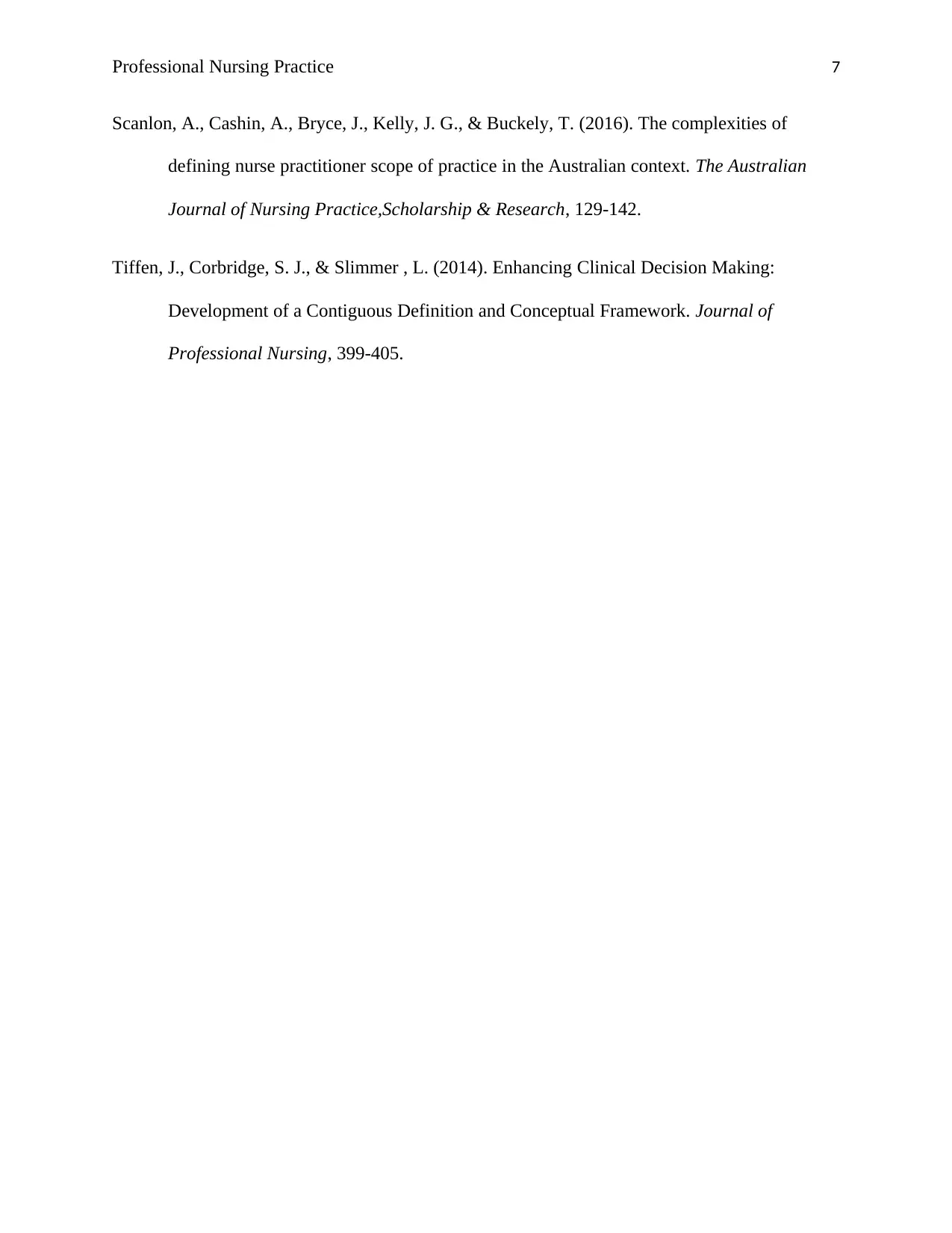
Professional Nursing Practice 7
Scanlon, A., Cashin, A., Bryce, J., Kelly, J. G., & Buckely, T. (2016). The complexities of
defining nurse practitioner scope of practice in the Australian context. The Australian
Journal of Nursing Practice,Scholarship & Research, 129-142.
Tiffen, J., Corbridge, S. J., & Slimmer , L. (2014). Enhancing Clinical Decision Making:
Development of a Contiguous Definition and Conceptual Framework. Journal of
Professional Nursing, 399-405.
Scanlon, A., Cashin, A., Bryce, J., Kelly, J. G., & Buckely, T. (2016). The complexities of
defining nurse practitioner scope of practice in the Australian context. The Australian
Journal of Nursing Practice,Scholarship & Research, 129-142.
Tiffen, J., Corbridge, S. J., & Slimmer , L. (2014). Enhancing Clinical Decision Making:
Development of a Contiguous Definition and Conceptual Framework. Journal of
Professional Nursing, 399-405.
1 out of 7
Related Documents
Your All-in-One AI-Powered Toolkit for Academic Success.
+13062052269
info@desklib.com
Available 24*7 on WhatsApp / Email
![[object Object]](/_next/static/media/star-bottom.7253800d.svg)
Unlock your academic potential
Copyright © 2020–2025 A2Z Services. All Rights Reserved. Developed and managed by ZUCOL.




